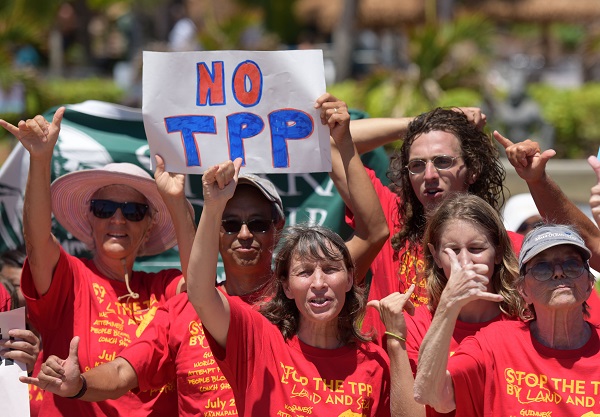

Follow us on:  
|


The TPP has not been popular among many Republicans and some sectors of the US workforce, giving Trump the ammunition to proceed with withdrawal. People attend a rally protesting the Trans-Pacific Partnership (TPP) in Maui, Hawaii, the United States, July 29, 2015 [Xinhua]
One of Trump’s first executive orders -making good on a campaign promise – was to withdraw the United States from the TPP, which had been billed as a counterweight of China’s influence in the Asia Pacific region.
The other 11 members moved quickly to try and salvage whatever trade agreement they could without the need for United States
At the time several countries such as Mexico and Japan said they would go ahead with the partnership without the United States, but there has been little impact from that trading Bloc since January 2017.
If the UK is to join the partnership it would mean it’s the first country that does not border the Asia-Pacific region to do so.
It might possibly impact both the UK and the remaining members of the TPP particularly in the case of a post-Brexit new economic reality.
But there are several hurdles in the path of UK membership.
The first is that the remaining 11 members of the TPP have not yet concluded their mandate and the scope of the bloc’s trade agreements.
Some critics say that while the UK may be looking to compensate for some of the financial loss that comes with Brexit by joining the TPP, it is still far too early to even consider European membership in this once hopeful trade bloc.
Other questions also arise weather other European countries such as Germany, France and the Netherlands, for example, will want to also join the TPP.
If it’s membership expands beyond the physical geography of the Asia Pacific region what’s the point of even having it, some may ask.
Meanwhile, international media pundits are warning that America’s retreat from the Asia-Pacific as it abandons the Trans-Pacific Partnership (TPP) is not only indicative of Trump’s commitment to isolationist and protectionist policies, but also paves the way for other countries to step in and fill the vacuum – chiefly, China.
The China-proposed Free Trade Area of the Asia Pacific (FTAAP) is now likely to be in focus as the TPP appears to crumble.
By Firas Al-Atraqchi for The BRICS Post